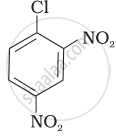Advertisements
Advertisements
प्रश्न
Which of the following statements are correct about the kinetics of this reaction?

(i) The rate of reaction depends on the concentration of only (b).
(ii) The rate of reaction depends on concentration of both (a) and (b).
(iii) Molecularity of reaction is one.
(iv) Molecularity of reaction is two.
उत्तर
(i) The rate of reaction depends on the concentration of only (b).
(iii) Molecularity of reaction is one.
Explanation:
SN1 occurs in two steps. I, the polarized \[\ce{C - Cl}\] bond undergoes slow cleavage to produce a carbonation and a chloride ion. The carbocation thus formed is then attacked by nucleophile in step II to complete the substitution reaction. Step I is the slowest and reversible. It involves the \[\ce{C - Cl}\] bond breaking for which the energy is obtained through salvation of halide ion with the proton of protic solvent. Since the rate of reaction depends upon the slowest step, the rate of reaction depends only on the concentration of alkyl halide and not on the concentration of hydroxide ion. So, the rate-determining step is unimolecular.
APPEARS IN
संबंधित प्रश्न
Arrange the compounds of the following set in order of reactivity towards SN2 displacement:
2-Bromo-2-methylbutane, 1-Bromopentane, 2-Bromopentane
Given reasons: The dipole moment of chlorobenzene is lower than that of cyclohexyl chloride.
Which of the following is a primary halide?
Isopropyl chloride undergoes hydrolysis by:
Which of the following compounds is optically active?
Which of the following alkyl halides will undergo SN1 reaction most readily?
Complete the following analogy:
Same molecular formula but different structures: A : : Non superimposable mirror images: B
Aryl halides are extremely less reactive towards nucleophilic substitution. Predict and explain the order of reactivity of the following compounds towards nucleophilic substitution:
| (I) |  |
| (II) |  |
| (III) |  |
CCl4 is insoluble in water because:-
Explain why Grignard reagents should be prepared under anhydrous conditions.
